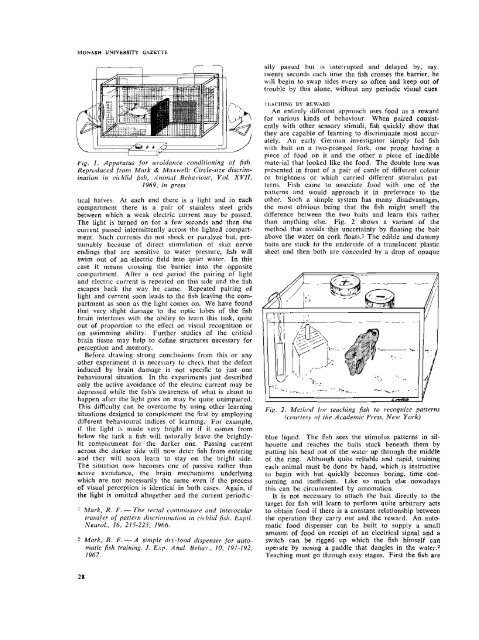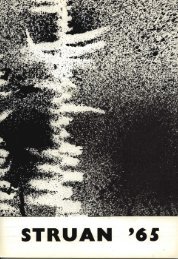GAZETTE - Adm.monash.edu.au - Monash University
GAZETTE - Adm.monash.edu.au - Monash University
GAZETTE - Adm.monash.edu.au - Monash University
- No tags were found...
You also want an ePaper? Increase the reach of your titles
YUMPU automatically turns print PDFs into web optimized ePapers that Google loves.
MON ....SH UN1V1:RSITY <strong>GAZETTE</strong>ally passed but is interrupted and delayed by, say.twenty seconds each time the fish crosses the barrier, hewill begin to swap sides every so often and keep out oftrouble by this alone, without any periodic visual cues.Fig. 1. Apparatus for avoidance conditioning of fish.Reproduced from Mark & Maxwell: Circle-size discriminationin cichlid fish, Animal Behaviour, Vol. XVII,1969, in presstical halves. At each end there is a light and in eachcompartment there is a pair of stainless steel gridsbetween which a weak electric current may be passed.The light is turned on for a few seconds and then thecurrent passed intermittently across the lighted compartment.Such currents do not shock or paralyze but, presumablybec<strong>au</strong>se of direct stimulation of skin nerveendings that are sensitive to water pressure, fish willswim out of an electric field into quiet water. In thiscase it means crossing the barrier into the oppositecompartment. After a rest period the pairing of lightand electric current is repeated on this side and the fishescapes back the way he came. Repeated pairing oflight and current soon leads to the fish leaving the compartmentas soon as the light comes on. We have foundthat very slight damage to the optic lobes of the fishbrain interferes with the ability to learn this task, quiteout of proportion to the effect on visual recognition oron swimming ability. Further studies of the criticalbrain tissue may help to define structures necessary forperception and memory.Before drawing strong conclusions from this or anyother experiment it is necessary to check that the defectinduced by brain damage is not specific to just onebehavioural situation. In the experiments just describedonly the active avoidance of the electric current may bedepressed while the fish's awareness of what is about tohappen after the light goes on may be quite unimpaired.This difficulty cnn be overcome by using other learningsituations designed to complement the first by employingdifferent behavioural indices of learning. For example,if the light is made very bright or if it comes frombelow the tank a fish will naturally leave the brightlylitcompartment for the darker one. Passing currentacross the darker side will now deter fish from enteringand they will soon learn to stay on the bright side.The situation now becomes one of passive rather thanactive avoidance, the brain mechanisms underlyingwhich are not necessarily the same even if the processof visual perception is identical in both cases. Again. ifthe light is omitted altogether and the current periodic1 A/ark, R. F. - The tecta! commissure and interoculartransfer of pattern discrimination in cichlid fish. Exptl.Neuro!., 16, 215-225, 1966.a Mark, R. F. - A simple drv-iocd dispenser for <strong>au</strong>tomaticfish training. J. Exn. Anal Behav., 10, 191-192,1967.TEACHING BY REWARDAn entirely different approach uses food as a rewardfor various kinds of behaviour. When paired consistentlywith other sensory stimuli, fish quickly show thatthey are capable of learning to discriminate most accurately.An early German investigator simply fed fishwith bait on a two-pronged fork, one prong having apiece of food on it and the other a piece of inediblematerial that looked like the food. The double lure waspresented in front of a pair of cards of different colouror brightness or which carried different stimulus patterns.Fish came to associate food with one of thepatterns and would approach it in preference to theother. Such a simple system has many disadvantages,the most obvious being that the fish might smell thedifference between the two baits and learn this ratherthan anything else. Fig. 2 shows a variant of themethod that avoids this uncertainty by floating the baitabove the water on cork floats.t The edible and dummybaits are stuck to the underside of a translucent plasticsheet and then both are concealed by a drop of opaque----..FiR. 2. Method for teaching fish to recognize patterns(courtesy of the Academic Press, New York)blue liquid. The fish sees the stimulus patterns in silhouetteand reaches the baits stuck beneath them byputting his head out of the water up through the middleof the ring. Although quite reliable and rapid, trainingeach animal must be done by hand. which is instructiveto begin with but quickly becomes boring. time consumingand inefficient. Like so much else nowadaysthis can be circumvented by <strong>au</strong>tomation.It is not necessary to attach the bait directly to thetarget for fish will learn to perform quite arbitrary actsto obtain food if there is a constant relationship betweenthe operation they carry out and the reward. An <strong>au</strong>tomaticfood dispenser can be built to supply a smallamount of food on receipt of an electrical signal and aswitch can be rigged up which the fish himself canoperate by nosing a paddle that dangles in the water.eTeaching must go through easy stages. First the fish are28
















